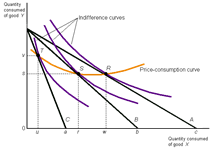
Главная страница Случайная страница
КАТЕГОРИИ:
АвтомобилиАстрономияБиологияГеографияДом и садДругие языкиДругоеИнформатикаИсторияКультураЛитератураЛогикаМатематикаМедицинаМеталлургияМеханикаОбразованиеОхрана трудаПедагогикаПолитикаПравоПсихологияРелигияРиторикаСоциологияСпортСтроительствоТехнологияТуризмФизикаФилософияФинансыХимияЧерчениеЭкологияЭкономикаЭлектроника
Monopoly. Marginal revenue and price elasticity of demand. The rule of profit maximization of a monopolist.
|
|
Monopoly is a market structure with one seller. The entrance to market is closed. Seller can influence to price of its good and consumers take price as given.
Profit of the company is p = TR-TC. Necessary condition to maximize profit is equality of derivative of p to zero: p' =  –
–  = 0. Since TR' = MR and TC' = MC then MR = MC. This means optimal quantity of production should be at that point when the marginal revenue of the company is equal to its marginal cost. And at that point curves of MR and MC intersects.
= 0. Since TR' = MR and TC' = MC then MR = MC. This means optimal quantity of production should be at that point when the marginal revenue of the company is equal to its marginal cost. And at that point curves of MR and MC intersects.
MR =  =
=  = p + Q
= p + Q  = p (1 +
= p (1 + 
 ) = p
) = p  and
and
Ep(D) =  so MR = (1 +
so MR = (1 +  ). If demand is inelastic and -1< Ep < 0, then MR< 0 and
). If demand is inelastic and -1< Ep < 0, then MR< 0 and  TR< 0, if
TR< 0, if  Q> 0. It means if Q increases TR will decrease and if Q decreases TR will increase. If demand is elastic and
Q> 0. It means if Q increases TR will decrease and if Q decreases TR will increase. If demand is elastic and  < Ep< -1, then MR> 0. It means if Q increases TR will increase and if Q will decrease TR will decrease. A monopoly cannot maximize profit in the inelastic range of demand because this involves negative marginal revenue, and by virtue of the profit-maximizing equality between marginal revenue and marginal cost, it requires negative marginal cost, which is just not a realistic possibility.
< Ep< -1, then MR> 0. It means if Q increases TR will increase and if Q will decrease TR will decrease. A monopoly cannot maximize profit in the inelastic range of demand because this involves negative marginal revenue, and by virtue of the profit-maximizing equality between marginal revenue and marginal cost, it requires negative marginal cost, which is just not a realistic possibility.
12. The “price-consumption " curve and individual demand curve.

 The Price Consumption Curve deals with two equally attractive products a consumer may be considering. The curve also takes into account the customer’s budget. The two products can be entirely different from each other, such as gas and food, and you assume the consumer wants or needs both of them. At the point where the price for the two products together is in the customer’s budget and she can have both of them, you find equilibrium. If you raise your price, the consumer may cut back on purchases of the other product for awhile, but a sustained price increase on your part can cause the buyer to forgo your product because of the perceived need for the other one over yours.
The Price Consumption Curve deals with two equally attractive products a consumer may be considering. The curve also takes into account the customer’s budget. The two products can be entirely different from each other, such as gas and food, and you assume the consumer wants or needs both of them. At the point where the price for the two products together is in the customer’s budget and she can have both of them, you find equilibrium. If you raise your price, the consumer may cut back on purchases of the other product for awhile, but a sustained price increase on your part can cause the buyer to forgo your product because of the perceived need for the other one over yours.
The lower the price, the higher the demand will be. The demand curve can have a steep slope or a gentle slope, depending on the product. This means that for some items, a slight change in price can greatly affect the demand for it, while other products experience a much steadier demand despite price changes.